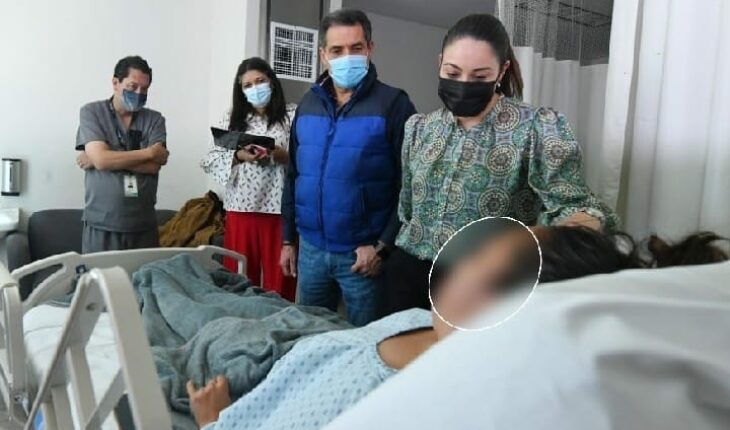Aneth’s sister gave birth by cesarean section at San Carlos Hospital on June 20. Two days later, she was discharged. Since then, he began to have a lot of sweating and spinal pain, which at first he thought was due to the injection into the lumbar area by the anesthesia known as the spine. For a month, her doctor only prescribed antibiotic by attributing it to a breastfeeding infection.
The sweating passed, but the spine pain did not. In early November, a headache and a sensation in his left eye added up as if he had been hit or swollen. The cases of meningitis in Durango were just beginning to be known, so ‘Aneth’ – whose name was changed for fear of reprisals in care – insisted that he ask the doctor if it was normal and if he had used his own anesthesia.
The doctor assured that this had been the case. When they tried to ask at the hospital, they were told that there had only been one suspected case, that it had been negative and that that of ‘Aneth’s sister’, if positive, would be the first. The hospital never admitted him or gave them an explanation, even though it is now closed. On December 1, the 35-year-old woman returned to the hospital because she could no longer stand the pain.
From ISSSTE, she was sent to General Hospital 450 for a CT scan. Afterwards, he had to return to the ISSSTE for a first lumbar puncture, in which cerebrospinal fluid was extracted to determine if he had meningitis. At first, the sample did not look normal, so he was informed that it would be sent to the CDMX. She was discharged without treatment and after 15 days she was informed that the study was positive, while the pain did not go away.
She was called for a second test, which was done three days ago. Once the sample was taken, they again told her that they would send her to the capital and, while they waited for the result, they would talk to her on the phone to start an outpatient treatment based on the first diagnosis, since the hospital was saturated to treat her there. So far, he is still waiting for the call.
Back and head pain and sensation in the eye persist. “That’s why they talked to him, because since it came out positive, they were going to give him treatment, but either they have a lot of people or I don’t know … He went to the ISSSTE to see if the doctor was there or someone told him, and they told him no, that he had to wait for the call, because they could not attend them as they wanted to go … There is the concern that it will get worse and they are letting it pass,” laments ‘Aneth’.
Many testimonies reveal similar stories: young women who had obstetric surgery and later, days, weeks or months apart, were diagnosed with meningitis. So far, most cases correspond to that history, all with neuraxial block.
Some women are still waiting for treatment. Others, even at 22 years of age, after giving birth at Hospital del Parque in August, remain hospitalized in intermediate therapy for more severe complications and struggling for proper care. All are among 75 confirmed cases of meningitis in Durango, including 27 deaths as of Friday.
#ATENCIÓN
Update cases for meningitis. pic.twitter.com/xzMk4CUdDe
— Ministry of Health (@SSDurango) December 22, 2022
The technical statement of the federal government with cut to December 20 details that, so far, one thousand 611 women and 190 men have been identified who underwent spinal anesthesia procedures between April 28 and October 31 of this year, in one of the four private hospitals where the contamination occurred. Of those people, one thousand 647 are in outpatient follow-up.
The Ministry of Health records October 5 as the start date of the outbreak. Of the 75 confirmed cases, 94.6% are women and 88% are associated with a history of gynecological-obstetric surgical procedures. August saw the highest peak of exposure, with 34 cases, while September saw 19 and October 10.
In 56% of cases, symptoms began between zero and seven days later; in 13.3%, between eight and 14; for 6.7%, from day 15 to 28, and for 22.7%, after 28 days. The most frequent symptoms were headache (91%), nausea (40%), vomiting (32%), neck stiffness (29%), visual disturbances (27%) and fever (25%).
As of 12 December, the age groups with the highest number of cases were 25-29 years, with 11 cases and seven deaths; 30 to 34, with 10 cases and six deaths, and 35 to 39, with nine cases and three deaths. In the following technical reports, the age graph began to be omitted.
Read: Arrest of administrators and owners of hospital orderedDeprived in Durango after deaths from meningitis
Diagnoses below expectations, says health secretary
In an interview, Irasema Kondo, Secretary of Health of Durango, said that the number of patients has not increased as initially expected. Of those confirmed, he explained that there are 25 who remain hospitalized: 12 in the General Hospital 450, one in the Maternal and Child Hospital, one in a hospital in Texas (USA), two in the National Institute of Neurology and Neurosurgery in the CDMX, three in the ISSSTE, two in Clinic 1 of the IMSS and four in the UMAE 71 of Torreón, Coahuila, also of the IMSS.
“New diagnoses have remained down, there have been several days that we have no new confirmations and patients who are on treatment have remained stable; Few have already presented complications. This tells us about a good response to treatment. We still cannot say that we are already successful, we still do not have patients discharged from the hospital, those who went home continue with medication and under surveillance,” he added.
Of the total universe of people who were at risk of exposure, totaling one thousand 801, only 33 have not answered follow-up calls or have not been located at home. “The rest of the patients have been located, contact has been made and the health status of all of them is known. The challenge is to be able to complete the screening of all these people to be able to give them the certainty that they are not sick, and that work is expected to take us about four weeks,” Kondo said.
On Thursday afternoon, the agency published a message that alerts: if from May to date you underwent surgery and had anesthesia by lumbar puncture (spine) in one of the four private hospitals and also have one or more of the following symptoms: headache, vomiting, nausea, neck stiffness, visual disturbances or fever, Call 800 82 22 200. “It is important to remember that this disease is not contagious between people, but it can be complicated and cause death,” the publication warns.
Kondo pointed out that, in addition to telephone follow-up, the agency has home care brigades, which have defined routes to monitor not only women who are on outpatient treatment, but all those who have identified themselves with risks of exposure or have manifested some symptoms. Also, he said, they have established coordination with other entities where people who were at risk were identified. To date, there are no confirmed cases in other states.
PAHO/WHO follows up; The origin is still unknown
On November 4, 2022, the National Liaison Center (CNE) of Mexico informed for the first time the Pan American Health Organization/World Health Organization (PAHO/WHO) of the detection of 11 cases of aseptic meningitis of unknown etiology, with one death, all with a history of surgical procedures with administration of epidural anesthesia in private hospitals in the city of Durango.
This is reported by the agency in a technical note released on December 10. On November 11, the Institute of Epidemiological Diagnosis and Reference (InDRE) confirmed the presence of the fungus that causes the disease in two samples that were under analysis. Between November 15 and 24, different batches of the drug bupivacaine were quarantined.
On December 8, the Federal Commission for the Protection against Sanitary Risks (Cofepris) reported that in the seven batches of medicines analyzed, the presence of the fungus was not detected. Although there are several lines of research, among which the main hypotheses are contamination by apocryphal drugs or needles, so far the true cause of the origin of the outbreak is not known.
PAHO/WHO said it is following up on the event together with Mexico’s health authorities: the Ministry of Health, Cofepris and the Durango Ministry of Health. Meanwhile, so far, four private hospitals are involved and have been closed: Del Parque, Santé, San Carlos and Dikcava. The state prosecutor’s office reported that more than 30 irregularities were found in them, and on December 5 it obtained seven arrest warrants against administrators and owners who remain at large.
Read: Immigration alert issued against hospital owners linked to meningitis outbreak in Durango
Kondo said surveillance has been strengthened in all private hospitals, and verification cards are being strictly enforced to ensure that procedures do not put patients’ health at risk. In addition to this, they have had meetings with the medical colleges and associations of private hospitals toProvide information and take the necessary precautions.
The origin of the outbreak remains under study and unknown. “We do not have to date any conclusion or any study where the presence of this fungus has been identified in the supplies or medicines seized in hospitals, in environmental microbiology samples either; We understand that they are still in process in the laboratories… We still do not have scientific evidence to be able to conclude where the source of contamination was. There are hypotheses, but we have no confirmation,” he admitted.
What we do at Animal Político requires professional journalists, teamwork, dialogue with readers and something very important: independence. You can help us keep going. Be part of the team.
Subscribe to Animal Político, receive benefits and support free journalism#YoSoyAnimal





